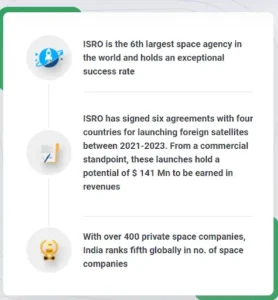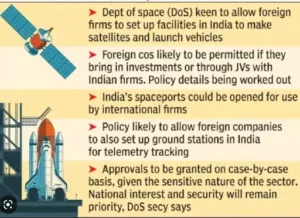Introduction
- India is commemorating its first-ever National Space Day on August 23, 2024, marking a historic achievement with the successful landing of ISRO’s Vikram Lander from Chandrayaan-3 on August 23, 2023.
- This landmark event signifies India’s growing prowess in space exploration, celebrating the importance of space science and technology.
New Space Launches
Aditya-L1 Mission:
-
- India successfully launched the Aditya-L1 spacecraft to study solar radiation from the Earth-Sun Lagrange point (L1).
- Launched aboard the Polar Satellite Launch Vehicle (PSLV), the mission reached its intended orbit around L1 by January 6, 2024.
- Notably, it tracked a significant solar storm in May 2024 in collaboration with ground observatories and lunar spacecraft.
- The mission’s completion of its first orbit by July 2, 2024, highlights India’s growing expertise in space weather monitoring.
Gaganyaan TV-D1 Test Flight:
-
- The Gaganyaan program achieved a significant milestone with the successful TV-D1 test flight. The crew module was separated from the Test Vehicle (TV) and safely recovered by the Indian Navy’s vessel, INS Shakti.
- This successful recovery is crucial for ISRO’s ambitions in human spaceflight, ensuring safety and reliability in future manned missions.
XPoSat Launch:
-
- The XPoSat, launched to study the polarization of radiation from celestial objects, is a pioneering mission following in the footsteps of NASA’s IPEX mission.
- This mission not only strengthens India’s position in space research but also contributes to global astrophysics by providing valuable data on cosmic radiation.
Reusable Launch Vehicle (RLV) Tests:
-
- ISRO’s Pushpak, a Reusable Launch Vehicle (RLV), underwent successful landing experiments simulating re-entry conditions.
- These tests are a precursor to the upcoming Orbital Return Flight Experiment, underscoring India’s focus on developing cost-effective space technology through reusability, which is crucial for reducing the cost of space missions.
Small Satellite Launch Vehicle (SSLV) Development:
-
- The SSLV program reached a critical milestone with the successful final test flight, confirming its readiness for commercial deployment.
- The payloads included earth observation instruments and an ultraviolet dosimeter for the Gaganyaan mission, demonstrating SSLV’s versatility and potential in meeting global demand for small satellite launches.
Read also: Wayanad Landslide: Kerala’s Deadliest Landslide | UPSC

Regulatory and Institutional Advancements
NewSpace India Ltd. (NSIL):
-
- NSIL has become the commercial arm of India’s space endeavors, managing activities such as the sale of Indian Remote Sensing satellite data.
- On May 1, 2024, NSIL signed a launch agreement with SpaceX for the GSAT-20/GSAT-N2 satellite, marking a significant collaboration.
- Additionally, NSIL has been advancing the production of LVM-3 and has secured a launch deal for SSLV with an Australian company, reflecting India’s expanding international partnerships in the space sector.
Private Sector Contributions:
-
- The Indian private space sector is witnessing rapid growth, with companies like Agnikul Cosmos launching their SoRTeD-01 vehicle, Skyroot Aerospace developing the Vikram 1 rocket, and Dhruva Space alongside Bellatrix Aerospace contributing to the PSLV-C58 mission.
- These advancements signify India’s shift towards greater private sector participation in space exploration.
Regulatory Developments:
-
- IN-SPACe, India’s space regulator, has updated its policies and issued several new licenses, including the first satellite broadband license to Eutelsat OneWeb and the first ground station license to Dhruva Space.
- Furthermore, the government has liberalized its Foreign Direct Investment (FDI) policy, allowing 100% FDI in most space sectors, while maintaining some restrictions on satellite manufacturing (74%) and launch infrastructure (49%).
Future Roadmap and Initiatives
Gaganyaan Program:
-
- ISRO’s Gaganyaan human spaceflight program is making steady progress, with the ambitious goal of establishing the ‘Bharatiya Antariksh Station’ (BAS) by 2035.
- This space station will position India among the elite group of nations with independent space station capabilities, enhancing its strategic and scientific stature globally.
Next-Generation Launch Vehicle (NGLV):
-
- ISRO is developing the Next Generation Launch Vehicle (NGLV), a three-stage rocket that will replace the GSLV.
- The NGLV will utilize semi-cryogenic, liquid, and cryogenic engines, enhancing India’s capacity to launch heavier payloads into orbit.
- The ongoing upgrades to the LVM-3 rocket, including the addition of a new semi-cryogenic engine, further underscore ISRO’s commitment to maintaining its competitive edge in space launch capabilities.
Significance of the Space Sector in India
Boost to Space Industrialization:
-
- India constitutes 2-3% of the global space economy and is expected to enhance its share to more than 10% by 2030.
- However, the expansion of the space sector is poised to drive significant industrialization, with the potential to grow the space economy to $100 billion by 2040.
- This growth is already evident in recent developments such as the launch of the Aditya-L1 mission and the SSLV’s successful commercial readiness.
- The upcoming Gaganyaan mission, set for 2025, is expected to open up further industrial avenues in human spaceflight and related technologies.
Rise of Private Space Entrepreneurs:
-
- India’s private space sector is flourishing, with 368 private space firms, placing the country fifth globally, ahead of nations like China, France, and Spain.
- This burgeoning entrepreneurial ecosystem is critical for sustaining India’s space ambitions and fostering continuous innovation.
- Recent examples include Agnikul Cosmos successfully launching its SoRTeD-01 vehicle and Skyroot Aerospace advancing its Vikram 1 rocket development.
- Additionally, companies like Dhruva Space and Bellatrix Aerospace have been instrumental in missions such as PSLV-C58, reflecting the growing investment and interest in space technology within the country.
Expansion of Outer Space Cooperation:
-
- Recent collaborations, such as NSIL’s launch agreement with SpaceX for the GSAT-20/GSAT-N2 satellite and the SSLV deal with an Australian company, highlight India’s growing influence in global space diplomacy.
- India is the 27th country to sign the Artemis Accords, which establishes a practical set of principles to guide space exploration cooperation among nations participating in NASA’s Artemis program.
- Aditya-L1 mission’s collaboration with global observatories to monitor solar storms demonstrates how space endeavors can strengthen both scientific and strategic capabilities.
Employment Generation:
-
- India’s space supports 4.7 million jobs in the country, a number that is set to go up as private payers foray into space research.
Complementary Aviation and Defence Sector:
-
- Bengaluru is ranked among top 3 in global aerospace and defence cities in attracting foreign investment and India is one of the top countries in the world in terms of defence procurement and allied production.
Emerging Areas In The Global Sector:
-
- Future opportunities in fascinating areas like space tourism and commercial recovery of space resources are coming up, promising enormous scope of growth in the sector.
Challenges in Developing Space Infrastructure in India
Budgetary Constraints:
-
- India’s space sector, despite its impressive achievements, faces significant budgetary challenges.
- For the 2023-2024 fiscal year, ISRO’s budget allocation was reduced by 8% compared to the previous year. This reduction impacts the availability of resources for new missions and the development of advanced technologies.
- For example, the reduced budget has led to delays in projects like the Next Generation Launch Vehicle (NGLV) and the Gaganyaan program, which are crucial for maintaining India’s competitive edge in space exploration.
- In contrast, countries like the U.S. and China have consistently increased their space budgets, enabling them to rapidly advance their space capabilities, leaving India at a relative disadvantage.
Manpower Challenges:
-
- ISRO is experiencing a shortage of skilled manpower, which is further exacerbated by the issue of brain drain and a declining number of students pursuing advanced studies in space sciences.
- For instance, the Chandrayaan-3 mission, while successful, highlighted the need for more skilled engineers and scientists to ensure the timely completion of complex space missions.
Legislative Framework Gaps:
-
- The absence of a clear legislative framework, such as the long-pending Space Activities Bill, continues to create uncertainty in the Indian space sector. This gap has deterred private investment and slowed the pace of growth.
- For example, the delay in passing the Space Activities Bill has left private players like Skyroot Aerospace and Agnikul Cosmos without comprehensive legal protections, leading to hesitancy in fully committing resources to large-scale projects.
Dispute Resolution Mechanism:
-
- The lack of a robust dispute settlement mechanism poses significant challenges for private investment in the Indian space sector. The Antrix-Devas case is a stark example, where the Indian government was ordered to pay $1.2 billion to Devas Multimedia by an international tribunal. This case underscores the risks and challenges faced by private entities in the absence of a reliable dispute resolution framework.
Technological Challenges:
-
- ISRO continues to face technological challenges, particularly in developing more powerful launch vehicles with higher payload capacities.
- For instance, while Chandrayaan-3 took nearly six weeks to reach the Moon, the Russian Luna-25 mission, despite its failure, attempted to do so in just one week. This comparison highlights the need for India to advance its launch technology to remain competitive in the global space race.
- The development of the Next Generation Launch Vehicle (NGLV) is one such effort, but budgetary and manpower constraints have slowed its progress.
Government-Driven Sector:
-
- India’s space sector is heavily dependent on government funding, which critics argue limits the government’s ability to invest in other critical areas such as education, healthcare, and poverty alleviation.
- For example, the heavy reliance on government resources for projects like the Gaganyaan mission has sparked debate over whether these funds could be better utilized in addressing pressing social issues.
- Encouraging private investment in the space sector could help diversify funding sources, reduce the burden on government finances, and allow for a more balanced allocation of resources towards broader development goals. This approach could also lead to increased innovation and efficiency in the space sector.
Read also: Understanding E-waste Management Challenges and Solutions | UPSC
Government Measures to Address Challenges
Indian Space Policy, 2023:
-
- The Indian Space Policy 2023 focuses on enhancing the participation of non-governmental entities (NGEs) in carrying out end-to-end activities in the domain and giving them a level-playing field.
- Indian customers of space technology and services like communication, remote sensing, data and launch services, etc. will now be able to procure these technologies and services directly from public and private sources.

IN-SPACe:
-
- IN-SPACe was established to provide a level playing field for private companies and facilitate their participation in space activities.
- By acting as an intermediary between ISRO and private players, IN-SPACe reduces bureaucratic hurdles and streamlines the process for private sector involvement in space missions.
FDI Policy Reforms:
-
- The government has amended its Foreign Direct Investment (FDI) policy to allow 100% FDI in most space sectors, with some restrictions on satellite manufacturing (74%) and launch infrastructure (49%).
- These reforms are intended to attract foreign investment and boost the development of space infrastructure in India.
NewSpace India Limited (NSIL):
-
- Established in 2019, NSIL is tasked with transferring technologies developed by India’s space program to the private sector.
- NSIL’s role is critical in enabling the Indian industry to scale up its high-technology manufacturing capabilities, thereby supporting the growth of the space sector.
Way Forward for India’s Space Sector
Increase Privatization:
-
- India should continue to reform its space policy to allow greater private sector participation in space technology and infrastructure.
- Encouraging private investment will drive innovation, reduce the burden on government resources, and accelerate the growth of the space industry.
Passage of the Space Activities Bill:
-
- The long-pending Space Activities Bill should be passed to provide legal clarity and protection for private players in the space sector.
- This bill should be developed in consultation with stakeholders to ensure it addresses the needs and concerns of all parties involved.
Establish a Space Dispute Tribunal:
-
- To attract more private investment, India should establish an independent tribunal to adjudicate disputes among private space entities.
- A reliable dispute resolution mechanism is essential for building investor confidence and fostering a healthy investment climate.
Strengthen International Collaboration:
-
- India should enhance its collaboration with leading space-faring nations such as the U.S. and Russia.
- By leveraging their expertise and experience, India can accelerate the development of its space infrastructure and remain competitive in the global space arena.
National Space Law:
-
- India has no well-defined national space laws like Canada, Germany and even Ukraine, which have a carefully drafted legal framework.
- It is time for India to formulate space laws that will not only address the demands of the Indian market as well as those of international investors but also give the nation negotiatory muscle necessary to compete in the international space sector.

